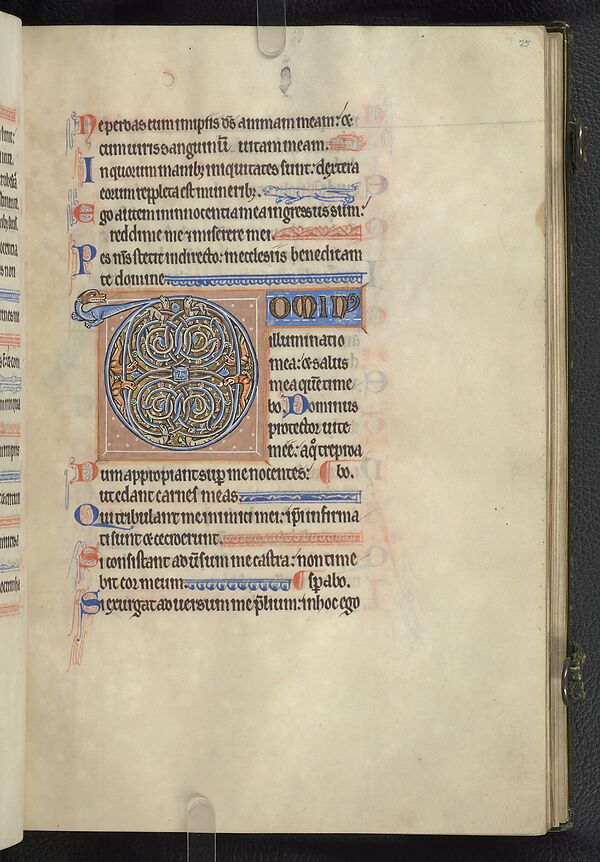Illuminated manuscripts.
Found in 106 Collections and/or Records:

'Iona Psalter'.
Late 14th-century manuscript of part of the 'Chronicle' of Walter of Guisborough.
Late 14th- or early 15th-century manuscript of the ‘Roman de la Rose’, written in two stages by Guillaume de Lorris, circa 1230, and Jean de Meun, circa 1270.
Late 15th-century manuscript of an incomplete copy of the verse drama 'Istoire de la destruction de Troye la grant' by Jacques Milet, composed between 1450 and 1452.
Late 15th-century manuscript, probably written in Italy, containing the 'Quaestiones' of Ugo Benzi (Hugo de Siena) and a medical work described as the sixth in a series of 'sermons', possibly related to the works of Nicolaus de Florentia.
Latin Bible written in France in the second half of the 13th century.
'Livre de I'ecclesiaste ensemble les Lamentations de leremie. De la main d'Esther Anglois françoise, a Lislebourg en Escosse, 1602', being a calligraphic copy of the books of Ecclesiastes and Jeremiah from a French Genevan version of the Bible.
Manuscript of the complete works of Catullus, written in the Italic bookhand of Lodovico Regio of Imola.
Manuscript of the translation by Jacobus Venetus of the 'Analytica Posteriora' by Aristotle, with contemporary and later gloss.
Manuscript on heraldry, written throughout in one hand of the late 15th or early 16th century.
Manuscript, possibly from Mount Athos, of St Dorotheus and the sermons of Isaias, with an account of the miracle performed by the Virgin at Blachernae.
Manuscript, probably written by Giovan Marco Cinico, of the Latin translation by Francesco Griffolini (formerly attributed to Francesco Accolti) of the spurious letters of Diogenes and Phalaris.
Manuscript, written by Antonio di Mario, of Jerome’s translation of ‘Chronici Canones’ by Eusebius, with the continuation by Prosper.
Subscription on folio 75 verso; ‘Ego Antonius Marii filius et Florentinus civis absolvi V. Idus Mai MCCCCXXVI quo tenpore ducalis illustrisque dominatio Venetorum simul cu(m) nostra repu(bli)ca Florentina colligatione facta pro earu(m) libertate tuenda adversus tyran(n)idem
Duce(m) Mediolanense(m) qui an(n)is iam elapsis iniquissime et iniuste contra dictam nostra(m) re(m) p(ublic)am Flo(renti)na(m) bellu(m) fecerat viriliter atq(ue)fortiter dimicabant Valeas qui legas’.
Manuscript, written in Italy, of the epitome by Junianus Justinus of 'Historiae Philippicae' by Trogus Pompeius, and of the prologues to that work.
Manuscripts from Blairs College Library.
Microfilm chiefly of photographs and prints of works of Phoebe Anna Traquair.
The contents are as follows:
Photographs of and printed articles concerning murals of Phoebe Anna Traquair, [1890-1948] (MS.8123);
Illuminated manuscript, 1895-1897, by Phoebe Anna Traquair of ‘Sonnets from the Portuguese’ by Elizabeth Barrett Browning (MS.8127);
Collotype prints of an illuminated manuscript, 1890-1892, by Phoebe Anna Traquair of ‘In Memoriam’ by Alfred Tennyson (MS.8128).
Microfilm of 13th-century manuscript of the 'Decretum' of Gratian.
Microfilm of 14th century copy of the ‘Historia Anglorum’ of Henry of Huntingdon, 12th century; and, late 14th century manuscript of the ‘Chronicle’ of Walter of Guisborough.
The contents are as follows:
English manuscript, 14th century, of the ‘Historia Anglorum’ of Henry of Huntingdon, 12th century (Adv.MS.33.5.2);
Manuscript written in England in the late 14th century by several hands of the ‘Chronicle’ of Walter of Guisborough (Adv.MS.33.5.3).
